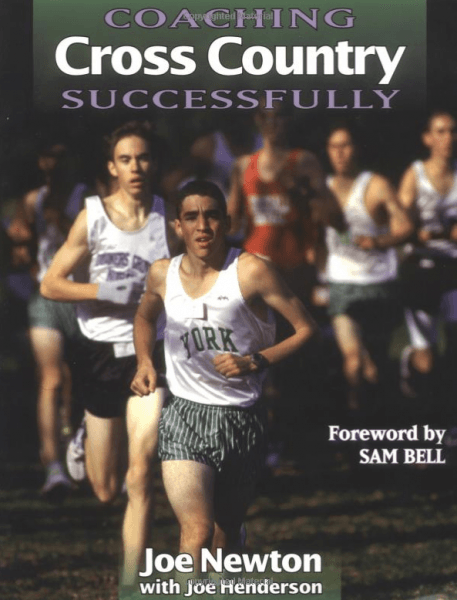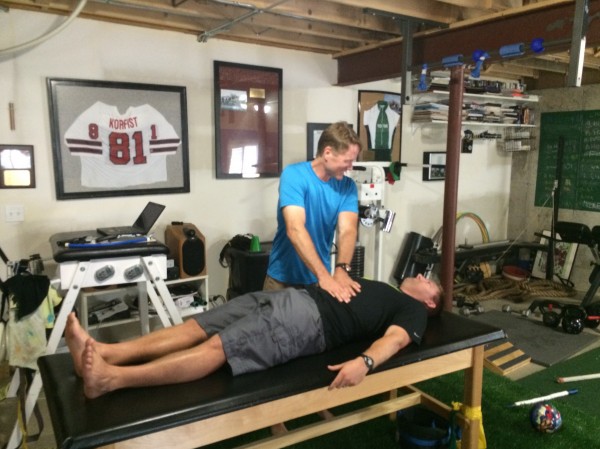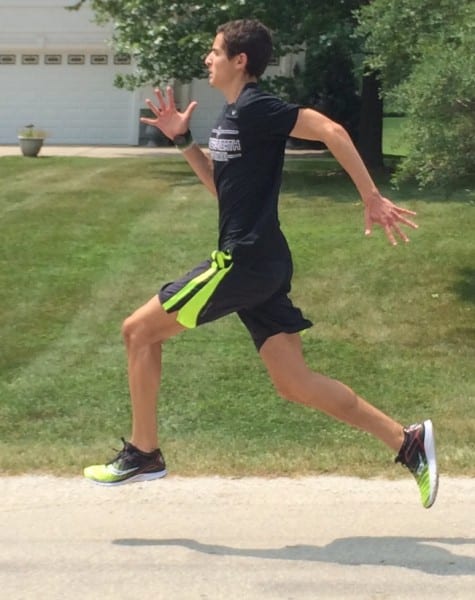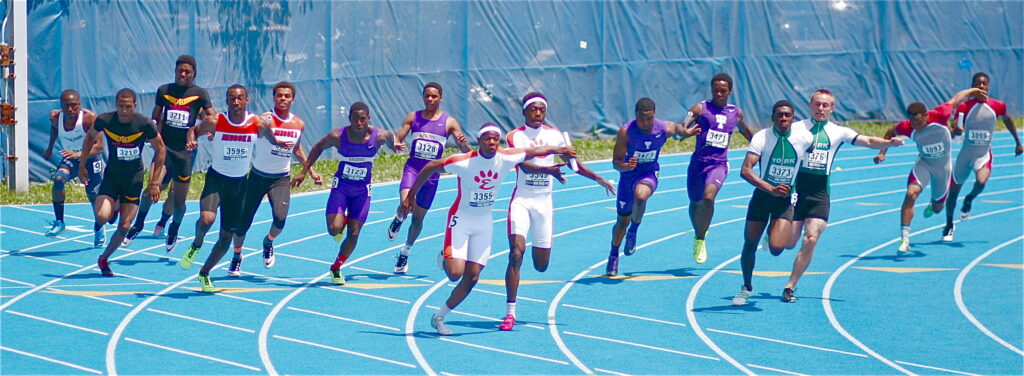
By Tony Holler
Follow Coach Holler on Twitter at @pntrack.
I am proud to say that I am a life-long learner. I read and I read and I read. I observe successful educators and question their ideas. I also learn from the mistakes of others.
However, it’s hard to look back on my younger days without some remorse. “Education: the path from cocky ignorance to miserable uncertainty.” – Mark Twain
Young coaches are full of piss and vinegar. I was. I have often admitted that I was a pretty good coach before I knew what I was doing.
“Good and bad, I define these terms
Quite clear, no doubt, somehow
Ah, but I was so much older then
I’m younger than that now”
– from the Bob Dylan song, “My Back Pages”
Without confidence, young coaches would second-guess themselves repeatedly. Teams reflect the confidence of their coach. When a team buys-in, good things always happen. I strongly urge coaches to act like they know what they are doing. Work on body language. Show confidence. Don’t be a worrywart and a handwringer.
As you are bluffing your way through your teaching and coaching career, be a learner. Go to clinics. Read books. Read online articles. Email experts. Visit gurus. Observe a master teacher. Attend a practice of a championship team. I’ve done all of the above. I am now cursed with what Mark Twain called “miserable uncertainty”. However, I am blessed with 35 years of teaching, coaching, and learning. I am reborn every day, excited to become a better coach. The best methods for coaching have yet to be discovered. There are so many moving parts, we will never find certainty. Coaching will always involve more than just science. The best coaches never read from a script. The best coaches will always be artists.
Is your mind open to something new?
“The only things that are going to change you from where you are today to where you are going to be five years from now are the people you meet and the books you read.” – Lou Holtz
And change we must.
Remember when stretching was an integral part of athletic training? Static stretching was unquestioned. Stretching prevented injuries, improved performance, and was a general cure-all. I wish I had a dime for every time I heard “stretch it out”. The only people I see stretching these days are football teams … the Neanderthals of the sports world … the tea-party science-deniers of our fraternity. Please let the football coaches at your school know that static stretching before exercise is known to impair a person’s strength and power and has no effect on injury prevention.
Here we are in 2014 and I still hear coaches telling athletes to stretch an injured muscle. In 2011, I wrote Boo Schexnayder about one of my sprinters who had a hamstring injury. Here was one of Boo’s points of emphasis, “NO STRETCHING. This accelerates the inflammation process and causes a two-week injury to last months. The relief felt from stretching results from the deadening effect on the proprioceptors (spindles), and is only temporary.” By the time I received this advice, my sprinter had gone to a trainer who had stretched him. My sprinter remained injured for months.

Sprained ankle? Ice it. Knee pain? Ice it. Tough workout? You guessed it – another job for ice. Everyone knows that ice is the cure-all for injury and soreness, just like everyone knows lobotomies are the cure-all for mental illness. And surely people still practice bloodletting – you know, where a medical professional intentionally cuts you and then attaches a leach to the wound to drain some blood.
Besides stretching, ice has always been the go-to answer for all sports injuries. Coaches who couldn’t pass a PE course prescribed ice with total confidence. “RICE” was all you needed to know. (Rest, Ice, Compression, and Elevation)
Did you know that ice is now in question? Check out the book written by Gary Reinl (twitter @TheAntiIceMan).
When in doubt, prescribe rest. Rest cures all, right? In that same email from 2011, Boo Schexnayder shared these points with me:
- The theme of rehab should be functional locomotive exercise that is pain-free. This gentle exercise limits scar tissue formation.
- Rehab must be functional and locomotive. Leg Curls, etc, are a waste of time unless the injury is so bad the athlete can’t walk. RDLs, squats, and other such exercises place excessive tension on the muscle.
- Exercise Progressions … Each day, 12×60 meters, progressing as possible over time through the following exercises, and progressing patiently enough to keep things pain-free. This is not all that can/will be done in training, but this is the specific hamstring rehab portion. 1. Walking, 2. Easy Jog 3. Jog 4. Run 5. Straight Leg Bounds 6. Sprint

An educator by profession and a mentor of hundreds of coaches, Boo Schexnayder has been very active in curriculum development for Coaching Education programs, and has lectured nationally and internationally on speed/power training programs, jumps and combined events training, biomechanics, and rehabilitation.
Let me narrow my focus. The curse of sprinting is the hamstring.
I have some of my own observations about hamstring injuries. My evidence is anecdotal over my 40-year track & field experience.
- The fastest sprinters injure their hamstrings most frequently
- In the 4×1, the anchor man has at least twice the likelihood of pulling his hamstring as the 1, 2, or 3 runners.
- Most hamstrings are pulled in warm weather at the end of the season. Cold weather is an over-rated cause of hamstring injuries.
- Multi-sport athletes are more durable than sprint specialists.
- Muscular thickly-built sprinters have more hamstring injuries than the greyhounds.
Prevention is Better than Rehab
Recently I read an article like this one, discussing the prevention of hamstring injuries. I am just a chemistry teacher and high school coach. The expert who wrote the article was a big-timer. He probably drives a fancy car and flies all over the country. This writer of the article in question restated the same old crap. Hamstring injuries are prevented in the weight room. Hamstring injuries are the result of a strength imbalance between the quads and the hamstrings. Hamstring injuries are the result of weak hamstrings.
If you can make a muscle sore by lifting weights, you make it bigger and stronger. Any lift that creates soreness creates strength. It’s all so simple. Injury comes from weakness. Coaches see everything in warrior’s terms … weak vs strong. The weight room is a temple, the genesis of all athletic success. Athletes with strong muscles are the best athletes and have the fewest injuries. Neanderthal mentality.
“The cause of a pulled hamstring is never a weak hamstring. The hamstring is like the lights on the dashboard of your car, they tell you there is a problem but aren’t the problem themselves. If you don’t fix the cause then then at best rehab will progress slowly, at worst the injury will re-occur.” – Boo Schexnayder
Incomplete evidence and small sampling supports dozens of theories.
My college coach sent his sprint group on 6-mile runs for Monday workouts. He believed that distance running created strong hamstrings. “You never see a distance runner pulling a hamstring.” Geez.
Jamaican sprint coach Maurice Wilson told me that retro running (sprinting backwards) up a gradual incline strengthens the hamstrings. Or maybe it’s the mountain yams.
I’m a huge fan of foam rollers and roller sticks but where’s the science?
Boo Schexnayder talks about displacement of the talus, tightness in the lumbar spine, or tightness in the hip flexor/rectus femoris as structural causes of hamstring injuries.
My jumps coach, Dr. Brian Damhoff of Elite Performance Institute, stresses dynamic warmup, glute activation, hip flexor tightness, running mechanics, and core breathing.
Are you feeling Mark Twain’s “miserable uncertainty” yet?
I Know a Guy
Actually, I know a guy who knows a guy. The guy I know is Chris Korfist. I have bought his DVDs. I am a frequent visitor to his training facility (his basement, driveway, and street). I have heard him speak at clinics multiple times. I have visited one of his practices at Elmhurst York High School. Last year he “fixed” one of my sprinters.

Joe Newton won 28 Illinois Cross Country State Championships and wrote four books. York was a distance school before Chris Korfist became their sprint coach.
Chris Korfist created a sprint culture at one of the most famous distance high schools in the nation. Former York coach Joe Newton is a legend.
Chris Korfist took everyday kids and made them special. The evolution of Chris Korfist’s coaching techniques would make Darwin’s head spin.
At the core, Chris Korfist believes in what I believe. Run fast to get fast. Less is more. Vertical force is the holy grail. Fly 10’s are more than diagnostic … fly 10’s are speed builders. If you don’t time sprints, it ain’t sprinting. The weight room hurts more athletes than it helps.
The newest and most exciting feature of Chris Korfist’s training is “activation”.
Last spring I had a sprinter who had been suffering from hamstring issues for 18 months. Chris Korfist “fixed” him. Quintin Hoosman returned to track & field and was a state qualifier. Quintin has nearly 500 yards rushing in his first two varsity football games this year.
Chris Korfist has learned how to activate muscles from a guy named Douglas Heel from Cape Town, South Africa.
The results are stunning. Injuries are virtually non-existent. Performance has been optimized.

Chris Korfist demonstrating activation techniques for Belleville West coach Patton Segraves. Segraves is one of the best young coaches in the state of Illinois. Segraves traveled 300 miles to visit Chris Korfist.
It’s been a pretty good year for Chris Korfist. Chris’s sprinters led Elmhurst York to the 2014 IHSA Track & Field State Championship. In addition, Chris worked weekly with the Hinsdale Central cross country team, the 2013 IHSA Cross Country State Champions. Another project is Ryan Clevenger of Downers Grove North. Clevenger ran 4:11.2 in the 1600 as a junior and may become one of our nation’s best distance runners. When I visited Chris is late July, I observed a one hour session with Clevenger and Billy Magnesen of Hinsdale Central. Magnesen was the #1 runner on Hinsdale’s state championship team coached by Jim Westphal. Magnesen is now running for the University of Illinois.

Ryan Clevenger is seen here after an activation session with Chris Korfist. Adding speed mechanics to Clevenger’s aerobic base will lead to many victories in the future. Clevenger’s coach, John Sipple, is one of the top distance coaches in Illinois.
Activation is like a tune-up for a car.
The process involves the pressing neurolymphatic points, pressure points that activate muscles. I have observed the process on three different occasions. If I didn’t know better, I would accuse Chris Korfist of voodoo or sorcery. But Chris Korfist is not the David Copperfield of track & field, he is a coach. Chris Korfist is best sprint coach I know.
We don’t live like our ancestors. During the last 40,000 years, our bodies evolved to respond to a lifestyle foreign to us now. Now we sit all the time. Our food is unlimited. Instead of living a life-long hunting trip, we sit. Our muscles have trouble staying in sync. Our nervous systems get confused. Strong muscles may be dysfunctional.
Imagine a sprinter sitting through seven class periods of 55 minutes with a slow six-minute walk between each class. When those athletes report for practice after school, are their muscles activated and in sync? Does dynamic warmup activate all muscles for all sprinters? Stretching? Jogging? Foam rollers?
If hip flexors are shut down, sprinting continues with the quads taking over. If the glutes are shut down , sprinting continues with the hamstrings taking over.
Quintin Hoosman had 18 months of hamstring problems. Quintin had big and powerful glutes but they were “worthless as a tub of goo”. Quintin’s glutes were not activated. His hamstrings had to compensate for his dysfunctional glutes. You don’t have to be an exercise physiologist to understand what happens next.
Once you learn “Be-Activated”, you can activate yourself. The sprinters of Elmhurst York High School activated each other before practice and before meets. York’s sprinters were activated, energized, and fast. They also stayed healthy. Healthy & fast sprinters win races. Fast sprinters win championships.

York in green and white uniforms placed 2nd in the 4×1 at the 2014 IHSA State Championships.
Where Do I Sign Up?
South African physiotherapist and kinesiologist Douglas Heel is coming to Chicago, October 18th and 19th. Sessions will last from 9 AM until 5 PM on both days. Those attending will learn the same activation techniques Chris Korfist has used to produce state champions. The cost is $450. Anyone interested in attending can contact Chris Korfist at [email protected].

Douglas Heel will be in the Chicago area October 18th and 19th. I am looking forward to it.
Unlike infomercials selling the latest exercise program guaranteed to give you a six-pack and the energy of a teenager, this program has been pioneered by successful coach. Chris Korfist is a high school teacher and a sprint specialist. Korfist has been on a life-long mission to become an expert on the subject of speed. Chris Korfist has not worked as a businessman, he has done his work in his basement, his driveway, and the street in front of his house. Chris Korfist has done his work with athletes.
This article is not an advertisement for Douglas Heel. I’ve never met the man. We have never spoken. I am simply a high school coach who has paid $450 to learn something new.
“It’s what you learn after you know it all that counts.” – Harry S. Truman
After 40 years of track & field study, I’m going to learn how to activate muscles.
The sessions will be hands-on. We will learn “Be-Activated” from the master.
“Tell me and I forget. Teach me and I remember. Involve me and I learn.” – Ben Franklin
[mashshare]


Nice article. I agree with a lot of the points. Just like ay article there are a few things that raises questions. Speaking with Dan Pfaff on a few occasions he has stated that in all his years he has never seen static stretching decrease power output. Not saying I agree with it but I think static stretching has some value some times. I do agree about not static stretching and injury. Being a “strength” coach I would say the statement about the weight room injuring more people than it helps would surely depend on who is running that weight room just as much as who the “track” coach is. I have seen bad strength session and bad track coaches as well. Pretty general statement. Being a strength coach but having a Physical therapy back ground I understand activation and bio mechanics and tonic and phasic muscle systems. the glute being a phasic and hamstrings being tonic and psoas being tonic as well which leads to the whole glutes being turned off and hamstrings over worked thing. Also upper traps being tonic and being upper trap dominat which leads to hamstring pulls. tight upper backs=pulled hamstings. Also inyour return to spring progression I would choose to skip my athletes over jogging them…rhythym skips(gym class style) then high knee skips and so on. Great article though and being from Illinois would like to visit if I ever got back that way.
Thanks for commenting on my article.
I agree with your statement, “Being a ‘strength’ coach I would say the statement about the weight room injuring more people than it helps would surely depend on who is running that weight room just as much as who the ‘track’ coach is. I have seen bad strength sessions and bad track coaches as well.” I’ve seen malpractice in the weight room and on the track … probably in equal numbers. My experience has been at the high school level. I’m sure the level of competence in college weight rooms is fairly high.
My statement “The weight room hurts more athletes than it helps”, is based on my observation of high school football programs. When I speak of the weight room “hurting” athletes, I do not mean “injure” athletes. I am referring to kids that lose their speed.
The worst thing that football promotes is weight gain. I’ve seen many athletes add pounds and subtract speed. Size is over-rated and the effect of weight on speed is under-rated. I’m tired of football players who drop out of speed training so they add 30 pounds to their frame. Bigger, Fatter, Slower is prevalent at too many high schools.
Much of what I see in high school weight rooms make me cringe.
If you are interested, I have written a sequel to this article at the Illinois Track Coaches’ website, ITCCCA. The article can be found by googling “Speed Never Sleeps”.
Tony. I see you made points on your article. My good friend of mines is sports performance personal trainer. He always assess and analyze young athlete on their running technique and find issues to fix the solution. Some coaches now days always tell kid run until you pass out that how injuries occur. You have a good quality trainer or strength coach who can address these issue which can be helpful to the team and coaching staff.
Wow, great stuff. I’m finishing my Masters in Exercise Science in a few weeks and have been a performance coach and track coach for 5 years (I’m 24 ha) and I’ve been reading all these activation articles wondering “what do I know?” This is great stuff. There are so many schools of thought it’s baffling. I’ve dealt with EXOS philosophy, learning AFS, and a host of other things and miserable uncertainty is true. It’ll probably get worse with more experience. I need to learn more about Doug Heel and this Be Activated. I’ve always focused on glute activation and strength, under the school of thought that unactivated (and weak) glutes lead to hamstrings, and lack of postural strength in the back leads to many other ailments. Much to learn. Thanks!
Thanks for reading and appreciating miserable uncertainty.
Lots of activation will be taught at Consortium III … https://www.freelapusa.com/track-football-consortium-iii/
I call BS. Just because some people write articles on activation and quote football coaches does not make it true. This year (2019) Lyons Township HS implemented activation over stretching and we have had more injured players before the first game than any other season with these same players (4th grade to this sophomore year). In the last play of the first game, my son suffered an avulsion fracture to his ankle. Another player in the injured list. I can quote sources too:
“Other possible causes of an avulsion fracture may include improper stretching and warm-up…” (References
Cluett, J. (2016, February 6). Avulsion Fractures. Retrieved from About: http://orthopedics.about.com/od/brokenbones/a/avulsion.htm
Luijkx, T., & Gaillard, F. (2015). Avulsion injuries. Retrieved from Radiopaedia: http://radiopaedia.org/articles/avulsion-injuries
Laskowski, E. (2014, May 8). Avulsion fracture: How is it treated? Retrieved from Mayo Clinic: http://www.mayoclinic.org/avulsion-fracture/expert-answers/faq-20058520
Dunbar, R., & Lowe, J. (2016, February). Pelvic Fractures. Retrieved from Ortho Info: http://orthoinfo.aaos.org/topic.cfm?topic=A00520
New Health Advisor. (2014). Avulsion Fracture in Ankle. Retrieved from New Heath Advisor: http://www.newhealthadvisor.com/Avulsion-Fracture-Ankle.html
Foot Education. (2015, July 26). Dancer’s Fracture (5th Metatarsal Avulsion Fracture). Retrieved from Foot Education: http://www.footeducation.com/foot-and-ankle-conditions/dancers-fracture-5th-metatarsal-avulsion-fracture/
Children’s Hospital Colorado Orthoedic’s Institute. (2014). Pelvic Avulsion Fracture: Signs and Symptoms. Retrieved from Children’s Hospital Colorado Orthoedic’s Institute: http://orthopedics.childrenscolorado.org/conditions/pelvic-avulsion-fracture/signs-and-symptoms
Kelly, J. I. (2015, October 21). Ankle Fracture in Sports Medicine Clinical Presentation. Retrieved from eMedicine: http://emedicine.medscape.com/article/85224-clinical#b4
ePain Assist. (2015). What is Pelvis Avulsion Fracture? Retrieved from ePain Assist: http://www.epainassist.com/sports-injuries/pelvic-groin-buttock-pain/what-is-pelvis-avulsion-fracture“